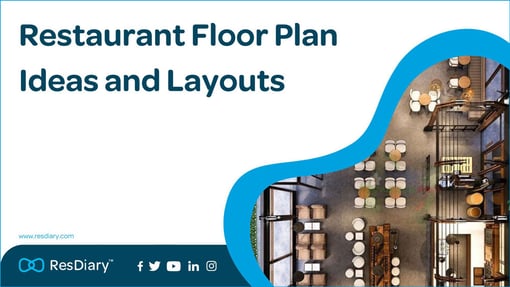When planning to open your own restaurant, there are plenty of factors to juggle and consider. From the very beginning of your decision to become a new owner, however, you need to ask yourself what type of restaurant you want to create.
Knowing what kind of restaurant you're going to create will aid in further vital steps such as your branding, venue design, and even a business plan. By looking into seven types of restaurants best suited and profitable for new owners, you can begin to create the foundations of your successful business.
What Makes Different Types of Restaurants Profitable?
The restaurant industry is known for its dynamic nature, with business ideas rising and falling in trends of customers' changing interests. However, new owners should not despair at entering this tumultuous environment. Rather, you should look forward to taking on the challenges that come with such a competitive market and turning a profit wherever possible.
Although some niche restaurant types will only experience increased revenue during moments when that niche concept becomes a societal trend, there are plenty of types that are stable in their profitability. In fact, it is the stability of their restaurant type that makes them so profitable.
There are various types of restaurants that are accepted in most cultures and business practices. This is because their service methods and atmospheres are generally agreeable to most. Think of fast food restaurants, which can be found in the smallest, most remote town of any country, to dozens in a metropolitan capital. The accessibility of these types of restaurants is what makes them so profitable.
It is also important to remember that a strong business strategy and quality food have just as much to do with your restaurant's success. So, be sure to consider all aspects of your new restaurant when deciding on a type.
What Type of Restaurant Should a New Owner Look For?
For new owners, a complex restaurant type is not advisable unless you have previous knowledge and experience in the restaurant industry. It is best to start simple and create a restaurant with an easy-to-realise concept and accessible business type. You can show off your strengths and passion in other areas of your restaurant, such as the menu items or the decor.
To help you determine which restaurant type is best suited for you as a business owner, it is essential to consider variables such as:
- Pricing
- Menu items
- Seating
- How food is served to customers
- Presentation
- What experience you want to create
- Staffing
- Your restaurant goals
How are Different Types of Restaurants Categorised?
What makes a restaurant type different from the next? How are restaurants categorised? Knowing the answer to these questions can help you narrow down which is the best option for you as a new owner.
Performing market research can also help you determine what type of restaurant will be competitive in your area. Looking into which types of restaurants are populating your area, and their marketing strategies for success can help you pick a type that will be profitable for you.
Types of restaurants are categorised by:
- Menu items: The type of cuisine served at a restaurant can set it apparent from other types.
- How products are served: Restaurants may only offer counter service, while others exclusively sell by delivery. It is more common with the rise of technology for restaurants to provide online ordering, but others may utilise mixed services of take-out and dine-in.
- Decor: If a restaurant has a theme or caters to a specific cultural cuisine, this is best displayed through the decor.
- Atmosphere: Most atmospheres of restaurants can be divided into two types; the elegance of formality, and the comfort of an informal setting. For example, a fine dining restaurant will have a more upscale atmosphere than the laid-back environment of family-style restaurants.
- Operating hours: Many restaurant types are distinguished by their opening hours, as they attract different diners at various times. For example, the relaxed atmosphere of early morning cafes will greatly vary from the chaos of late-night fast food restaurants.
- Physical location: Nowadays, restaurants can exist in a greater capacity than a physical storefront with counter service. Mobility is now attainable with food trucks, while others exist entirely as a virtual restaurant concept.
- Pricing model: One restaurant concept may choose to take advantage of high customer turnover to provide low prices. Alternatively, a unique experience may come with a higher price tag that customers are willing to pay for the journey. Buffet-style restaurants are also a distinct pricing model as they utilise the motto of "all you can eat".
- How the service is structured: A restaurant will typically stick to one particular method of service, only occasionally combining them if their products are served a certain way. Common structures include: table service, counter service, self-service, and online ordering.
Understanding the differences between these factors is what will allow you to choose which type of restaurant meets the needs of your target audience. It can also help you establish your desired profit margins, how your staff will be structured, and many more necessary aspects of running a new business.
7 Profitable Types of Restaurants for New Owners
With so many types of restaurants to consider, how do you know which are the most profitable as a new owner? We have provided the top seven restaurant concepts, ranging from full-service restaurants to something more casual and mobile, so you can begin creating your very own design.
1. Fine Dining Restaurants
If you are enthusiastic about creating an establishment known for its classiness and decorum, a fine dining restaurant is the type for you. Table service goes above and beyond what is expected in these restaurants, with each guest treated with utmost grace and personalised service. Guests are expected to respond in kind, following strict dress codes to enhance the feeling of exclusivity.
The style of service in a fine dining restaurant typically follows multiple courses, using uncommon ingredients presented elegantly on the plate. These establishments are also almost always sit-down restaurants with full-table service, making them popular choices for special occasions such as birthdays, anniversaries, or even weddings.
Benefits of Fine Dining Restaurants
Fine dining restaurants offer a unique experience of the finer things in life. People's desire to enjoy this has not lessened over the years, even with the temporary pause to seated dining the pandemic caused. For those trying to break into the food industry, a fine dining establishment is a profitable type of restaurant.
Formality and price are the main focuses of fine dining establishments. You are usually capable of charging more per food item due to its quality, presentation, and uniqueness. This increases your revenue, balancing it against the additional costs needed for niche ingredients, fine decor, and aged wines, among other luxuries.
While you may start out as an owner of a brand-new fine dining restaurant, it is possible to franchise your business with time and success. This can provide a broader sense of appeal and extend your reach to a greater target audience. Otherwise, you can restrain yourself to a single physical location to increase the sense of exclusivity.
2. Casual Dining Restaurants
A fine dining experience may be an excellent way of celebrating milestones in life or treating yourself to luxury meals, but they are generally not people's preferences for everyday meals. That is where casual dining restaurants enter, offering moderately priced food and a comfortable environment to relax in.
Diners, independent establishments, and even some popular franchises are considered casual dining restaurants. They cater to the everyday person, often offering promotions and easy accessibility.
There are various sub-types of restaurants labelled as casual, including:
- Fast-casual restaurant: The efficient service of a fast food restaurant, combined with a healthier and unprocessed food menu. Common features of fast-casual restaurants include ordering and picking up at the counter, as well as self-service drink stations. There is rarely any serving staff for tables, instead incorporating seated and takeaway service.
- Contemporary casual restaurant: You can enjoy seated table service at contemporary casual restaurants with a distinct theme and a contemporary menu. Vegan and gluten-free menu items are common, with both independent and chain restaurants providing eco-friendly practices. This type of restaurant typically caters to a younger audience of 20-year-olds.
- Casual eateries: An eatery usually does not provide table service or places to sit. Instead, pre-prepared food is offered for takeaway, making it an establishment with a very casual atmosphere. Bakeries or small coffee shops are common examples of an eatery.
Benefits of Casual Dining Restaurants
One of the greatest benefits of casual dining establishments is the high turnover rate of tables. If you capitalise on the rapid pace of customers coming and going, you can see a distinct increase in revenue. Especially as casual restaurants often attract group bookings and families with kids, ensuring that your seats are regularly filled during peak operating hours.
The moderately priced food is also achievable as your ingredients and preparation do not have to fit fine dining expectations. Therefore, the costs involved with these aspects remain low, but the food remains enjoyable. This affordability makes casual dining restaurants popular for most audiences, ensuring that you will have customers throughout every season.
3. Fast Food Restaurants
Speedy and efficient service is the aim of fast food joints, earning them the name of quick service restaurants. Most menu items in these establishments can be prepared in a matter of minutes, using precooked or frozen ingredients that are reheated. The name of 'fast food' came from how orders are served in disposable or takeout packaging.
While fast food chains typically dominate this corner of the restaurant market, creating your own business around this model is highly profitable. The lack of unique equipment or expensive decor also makes it an easy type of restaurant to understand and utilise for newcomers to the industry.
Benefits of Fast Food Restaurants
Fast food restaurants are acknowledged as one of the types of eating establishments with the highest profit margin. The exact amount depends on the size of the business, its exact model, and the costs of both staff and ingredients. However, with average profit margins remaining consistent, a quick-service restaurant is a stable choice for most new owners.
You can also save costs by excluding dinnerware and flatware that are necessary for full-service dining. This lack of necessity extends even to kitchen equipment, with most fast food restaurants requiring less complex equipment like deep fryers and microwaves.
If you are not ready or interested in opening a fast food establishment of your own, you can become an owner of a store in an existing franchise. This means you will not have to shell out extra for advertising costs, instead relying on existing brand power.
4. Pop-Up Restaurants
A pop-up restaurant is an excellent type of restaurant for those looking to try out new business ideas or concepts. This is because such restaurants utilise a temporary space for a short period of time, testing out a potential menu on a specific customer audience. Thus, you can experiment with your new restaurant ideas and possible business models with the flexibility of a pop-up restaurant.
There are various ways you can approach the pop-up method of these restaurant categories. You can choose to perfect a specific method of business and menu, "popping up" at popular events like festivals or markets. This allows you to cement your brand and gain notoriety in your local community. Alternatively, you can use a pop-up restaurant as the catalyst for your business' growth into a food truck, takeaway venue, or dining room establishment.
Benefits of Pop-Up Restaurants
The greatest convenience of a pop-up store is the chance to try out a new idea or menu without spending significant money on a brick-and-mortar store. There is no need to worry about costs of equipment, furniture, or even dinnerware as most pop-up restaurants are simple in both the kitchen and its offering of takeaway food.
Those interested in establishing themselves in the restaurant industry will benefit from using a pop-up establishment as a test to see if they are ready for the challenge. This type of restaurant allows you to work out any issues in your business model and determine whether you want to continue this work into a new, more permanent type.
5. Food Trucks
Food trucks are the mobile restaurant type that can be typically found at any community event, usually offering a specific cuisine. They were the inspiration for pop-up restaurants, although these are typically found in the form of tents, gazebos, or simple stands.
A food truck always offers food from a vehicle outfitted with a small kitchen and no attached seating area. While some food truck owners may provide some simple seating near their establishment, it is not a requisite. Thus, additional costs can be cut for new business owners by focusing on a takeaway model.
Benefits of Food Trucks
The startup costs associated with food trucks are often as low as your menu prices. Increase your revenue management capabilities and profit margin by optimising your menu to contain the most popular options. Then, simply ensure you have enough ingredients to keep these items rolling out all night and watch the turnabout draw in the money.
The mobility of food trucks means that you can always follow the hungry crowds. This guarantees a constant stream of business, especially during the warmer months which brings festivals, concerts, and other outdoor events. This lack of a brick-and-mortar store also means you will never need to rent or buy a space, and minimal staffing is required. More money is saved, meaning a higher profit margin.
6. Ghost Restaurants
While a ghost restaurant may sound spooky, it is not the presence of poltergeists or wailing women that give it its name. Rather, ghost restaurants are referred to as such because they are businesses without a dining room. Other names for this type of restaurant include a satellite or virtual restaurant.
This restaurant type thrives on delivery and the occasional takeaway service. They utilise third-party delivery services to obtain customer orders and deliver the goods to them, cutting out the need for a full-service restaurant. Additionally, this particular restaurant model became popular throughout the pandemic and beyond due to the simplicity of its service method.
Benefits of Ghost Restaurants
Offering only delivery and takeout from a ghost restaurant means that there is a distinct lack of operational costs. There is no need to create an establishment that appeals to customer interests as there is no physical restaurant. Rather, focus and money can be turned towards creating quality food and customisable items for greater accessibility.
New consumer expectations are also easily met by this restaurant type, despite the lack of counter service seen in traditional restaurants. The moderately priced menu in these establishments appeals to many diners, but you are sure to profit from the smaller investment and reduced staff. For new owners, working solely out of a commercial kitchen or a home can also be a more welcoming environment, bringing a sense of confidence to your business.
7. Buffet Restaurants
The "all you can eat" pricing and serving style of buffet-style restaurants is a unique type of eatery. Table service is not the focus of this restaurant type. Rather, self-service is the focus, with customers allowed to fill up their plates and cups as many times as they would like for a flat price.
The affordability and significant amount of food offered by these types of restaurants make them incredibly popular. While you are not likely to find delicate and pricey dishes on offer, the diversity of savoury and sweet meals available makes up for this. These dishes are often comfort foods that are well-known by most people, making buffets akin to a family-style restaurant as customers of all ages can find something to enjoy.
The simplicity of this restaurant model, as well as its staffing and food, makes it a good type for new owners. Most of your focus will be towards ensuring there are enough ingredients for each day, rather than balancing service style with fancy decor or food presentation.
Benefits of Buffet Restaurants
The significant amount of food available at a buffet restaurant makes it seem impossible for you to turn a profit. However, while most profits go towards stocking ingredients, money can be saved in other areas of this restaurant type.
The self-serving style of business means that a very small staff team is required to operate a buffet restaurant. Most of the staff are cooks, who prepare food ahead of time and do not require long operational hours. Thus, labour costs remain low, widening your profit margin as needed.
On top of this, buffets are designed to facilitate a large number of guests. The sheer volume of seated customers per day is what makes a significant profit, especially when you ensure the turnover rate remains just as high.
Open Your New Restaurant With ResDiary
Knowledge is power, and nowhere is this more evident than when it comes to opening your own restaurant. By understanding what types of restaurants are available, and what would best suit your interests and skills as a new owner, your journey towards success becomes much smoother.
Keep the momentum going by utilising our Restaurant Floor Plan Guide to maximise your restaurant's efficiency, profitability and overall experience for your customers and employees.
.jpg)

.jpg)

